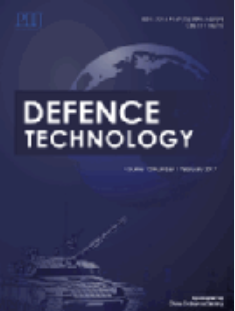Study on the effects of combustion characteristics of pyrotechnic charges on pyrotechnic shocks
IF 5.9
Q1 ENGINEERING, MULTIDISCIPLINARY
引用次数: 0
Abstract
This study calculates the combustion characteristics of various gas-generating and micro gas pyrotechnic charges, including aluminium/potassium perchlorate, boron/potassium nitrate, carbon black/potassium nitrate, and silicon-based delay compositions, using thermodynamic software. A multiphase flow-thermal-solid coupling model was established, and the combustion process of the pyrotechnic charges within a closed bomb was simulated. The pyrotechnic shock generated by combustion was predicted. The combustion pressures and pyrotechnic shocks were measured. The simulation results demonstrated good agreement with experimental results. Additionally, the mechanism of shock generation by the combustion of pyrotechnic charges in the closed bomb was analyzed. The effects of the combustion characteristics of the pyrotechnic charges on the resulting pyrotechnic shocks were systematically investigated. Notably, the shock response spectrum of the gas-generating pyrotechnic charges is greater than that of the micro gas compositions at most frequencies, particularly in the mid-field pyrotechnic shocks (3–10 kHz). Furthermore, the pyrotechnic shocks increase approximately linearly with the impulse of the gas-generating pyrotechnic charges.
研究烟火装药的燃烧特性对烟火冲击的影响
本研究使用热力学软件计算了各种气体生成和微气体烟火药的燃烧特性,包括铝/高氯酸钾、硼/硝酸钾、炭黑/硝酸钾和硅基延迟成分。建立了多相流-热-固耦合模型,模拟了密闭弹内火药装药的燃烧过程。对燃烧产生的烟火激波进行了预测。测量了燃烧压力和烟火冲击。仿真结果与实验结果吻合较好。此外,还分析了火药药在密闭弹内燃烧产生激波的机理。系统地研究了火药装药燃烧特性对产生的火药冲击的影响。值得注意的是,在大多数频率下,产生气体的烟火药的冲击响应谱大于微气体成分的冲击响应谱,特别是在中场烟火冲击(3-10 kHz)。此外,烟火冲击随气体产生的烟火装药的冲量近似线性增加。
本文章由计算机程序翻译,如有差异,请以英文原文为准。
求助全文
约1分钟内获得全文
求助全文
来源期刊

Defence Technology(防务技术)
Mechanical Engineering, Control and Systems Engineering, Industrial and Manufacturing Engineering
CiteScore
8.70
自引率
0.00%
发文量
728
审稿时长
25 days
期刊介绍:
Defence Technology, a peer reviewed journal, is published monthly and aims to become the best international academic exchange platform for the research related to defence technology. It publishes original research papers having direct bearing on defence, with a balanced coverage on analytical, experimental, numerical simulation and applied investigations. It covers various disciplines of science, technology and engineering.
 求助内容:
求助内容: 应助结果提醒方式:
应助结果提醒方式:


